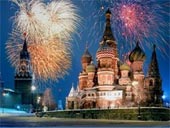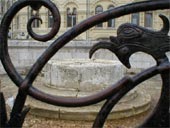In order to send a request or get more detailed information please contact travel@r-tg.com or fill in the booking forms below:
Tours Order Form
Hotel Order Form
Transfer Order Form
Tickets Order Form
or call us at our toll free number 1-866-387-5141.
St. Basil's Cathedral
 Red Square’s most famous and eye – catching structure is St. Basil’s Cathedral. This extraordinary creation was erected by Ivan IV ( the Terrible) from 1555 to 1561, to commemorate the annexation to Russia of the Mongol states of Kazan and Astrakhan. Since this occurred on the festival of the Intercession of the Virgin, Ivan named it the Cathedral of the Intercession on the Moat (there used to be a moat it). The names of the architects were unknown until 1896, when old manuscripts mentioning its construction were found. According to legend, Ivan the terrible had the two architects, Posnik and Barma, blinded so they could never again create such a beautiful church. However records from 1588, a quarter of a century after the cathedral’s completion, indicate that Posnik and Barma built the chapel at the northeast corner of the cathedral, where the holy prophet Basil (Vasily) was buried. Canonized after his death, Basil the Blessed (known as a Yurodivy, or “Fool in Christ”; a Yurodivy was a half – wit, thought to have a direct connection to God) died the same year (1552) that many of the Mongol Khannates were captured. Basil had opposed the cruelties of Ivan the Terrible, and since most of the population also despised the czar, the cathedral took on the name of St Basil’s after Ivan’s death. It was later, in the 17th century that the church was given its more colorful appearance. Red Square’s most famous and eye – catching structure is St. Basil’s Cathedral. This extraordinary creation was erected by Ivan IV ( the Terrible) from 1555 to 1561, to commemorate the annexation to Russia of the Mongol states of Kazan and Astrakhan. Since this occurred on the festival of the Intercession of the Virgin, Ivan named it the Cathedral of the Intercession on the Moat (there used to be a moat it). The names of the architects were unknown until 1896, when old manuscripts mentioning its construction were found. According to legend, Ivan the terrible had the two architects, Posnik and Barma, blinded so they could never again create such a beautiful church. However records from 1588, a quarter of a century after the cathedral’s completion, indicate that Posnik and Barma built the chapel at the northeast corner of the cathedral, where the holy prophet Basil (Vasily) was buried. Canonized after his death, Basil the Blessed (known as a Yurodivy, or “Fool in Christ”; a Yurodivy was a half – wit, thought to have a direct connection to God) died the same year (1552) that many of the Mongol Khannates were captured. Basil had opposed the cruelties of Ivan the Terrible, and since most of the population also despised the czar, the cathedral took on the name of St Basil’s after Ivan’s death. It was later, in the 17th century that the church was given its more colorful appearance.
The cathedral is built of brick in traditional Russian style with colorful, asymmetrical, tent-shaped, helmet and onion domes situated over nine chapels, each dedicated to a saint on whose feast day the Russian army won a victory. The interior is filled with 16th and 17th century icons and frescoes, and the gallery contains bright wall and ceiling paintings of red, turquoise and yellow flower patterns. Locals often refer to the cathedral as the “stone flower in Red Square”. The French stabled their horses here in 1812 and Napoleon wanted to blow it up, and later Stalin tried to destroy it after he had demolished the Savior Cathedral. Luckily, both never succeeded.
The interior, now open to the public, has been undergoing a very slow restoration. (The centuries have also taken their toll on outside of the structure; city and religious officials are trying to raise funds to give the cathedral a much needed facelift.) Inside is a branch of the Historical Museum that traces the history of the cathedral and Ivan IV’s campaigns. Under the bell tower (added in the 17th century) is an exhibition room where old sketches and plans trace the architectural history of St Basil’s.
 In 1991, the cathedral was given back to the Russian Orthodox Church to celebrate Russian New Year and Easter services; Yeltsin attended the first Easter service. In 2001, the cathedral began a three – year long restoration process, but remains open to the public. It was last renovated in 1979. In 1991, the cathedral was given back to the Russian Orthodox Church to celebrate Russian New Year and Easter services; Yeltsin attended the first Easter service. In 2001, the cathedral began a three – year long restoration process, but remains open to the public. It was last renovated in 1979.
In front the cathedral stands the bronze Monument to Minin and Pozharsky, the first patriotic monument in Moscow built from public funding. It originally stood in the middle of the square. Sculpted by Ivan Matros in 1818, the monument depicts Kozma Minin and Prince Dmitri Pozharsky, whose leadership drove the Polish invaders out of Moscow in 1612. The pedestal inscription reads “To Citizen Minin and Prince Pozharssky from a grateful Russia 1818”.
 Near the monument is Lobnoye Mesto, the Place of Skulls. A platform of white stone stood here for more than four centuries, on which public executions were carried out. Church clergymen blessed the crowds and the czar’s orders and edicts were also announced from here. Near the monument is Lobnoye Mesto, the Place of Skulls. A platform of white stone stood here for more than four centuries, on which public executions were carried out. Church clergymen blessed the crowds and the czar’s orders and edicts were also announced from here.
|

